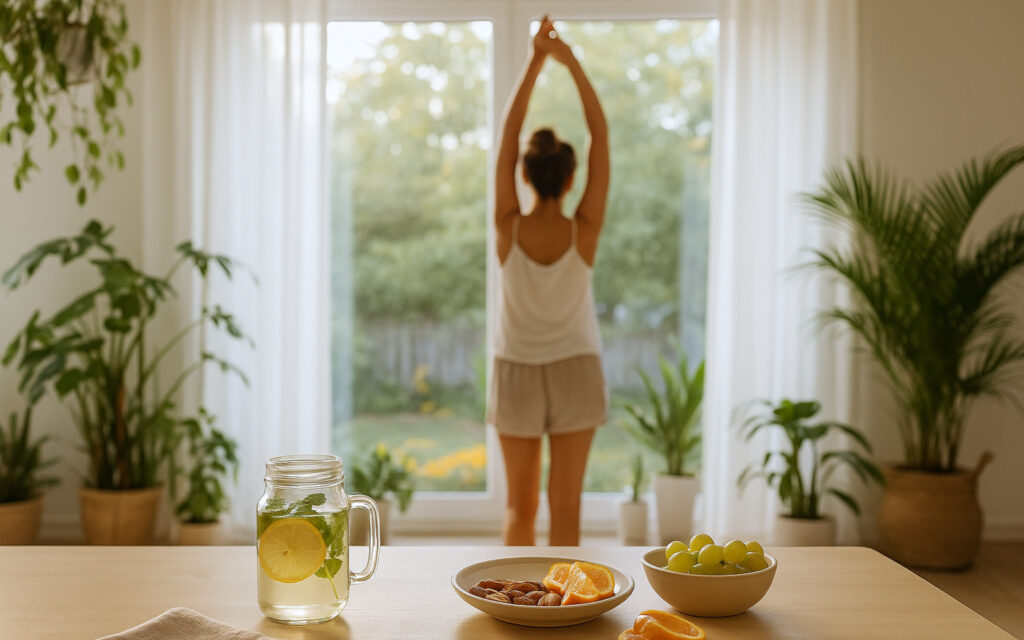“Sure,” you might be thinking, “but who has time for rituals when you’re rushing to work, kids are yelling, and the coffee machine is already judging you?”
Fair question. In a world that runs on speed, the idea of a slow morning might feel like a spa-day fantasy. But science—and many tired women—say otherwise.
According to behavioral researcher James Clear (Atomic Habits), “You don’t rise to the level of your goals—you fall to the level of your systems.” A slow morning isn’t a luxury; it’s a system. And systems begin small.
But here’s the truth: the way you spend your first 20–30 minutes in the morning directly shapes your energy, focus, and mood for the rest of the day. And it’s not just about skincare.
Neuroscientists emphasize the power of early daylight exposure, gentle movement, and nutrient intake to stabilize cortisol and improve mood. According to research from the University of British Columbia, even 10 minutes of light exercise in the morning can significantly reduce symptoms of anxiety and boost brain function.
So what does a truly restorative morning look like? It begins before your phone and lasts longer than your serum.
A Science-Based Slow Morning Ritual (20–30 min)
1. Light + Movement (5–10 min) Step outside, stretch or walk slowly. This regulates circadian rhythm and lowers cortisol. Even standing near a window and raising your arms overhead will help.
2. Hydration + Nervous System Reset (5 min) Start with warm water or herbal infusions (like lemon balm or tulsi). This signals safety to your nervous system and supports digestion.
3. Nourishing Breakfast (10–15 min) Choose protein and fat-based foods (like eggs, chia pudding, or nut butter on rye toast) to support blood sugar stability and hormonal clarity. Avoid quick sugars—they spike, then crash your mood.
4. Skin Care + Sensory Awareness (5 min) Cleanse gently, mist with spring water or floral hydrosol, and apply oil or cream while skin is damp. As you touch your face, breathe. Notice temperature, scent, texture. This grounds your awareness.
5. Emotional Orientation (2–3 min) Before stepping into your role(s), ask: How do I want to feel today? This inner check-in activates the prefrontal cortex and sets intention—both neurologically and emotionally.
Why It Works
- Sunlight exposure boosts serotonin and anchors circadian rhythm (Huberman Lab)
- Gentle movement increases dopamine and oxygenation
- Protein-based breakfast reduces mood swings and supports hormone balance (Harvard School of Public Health)
- Mindful skin rituals activate parasympathetic tone and reduce cortisol
You don’t need to do it all, every day. But when you do, the difference is tangible: steadier energy, clearer thinking, softer skin.
Common Mistakes That Disrupt Your Morning Energy
Even with the best intentions, some habits quietly hijack your calm. If your mornings still feel scattered, you might be unknowingly doing one of these:
- Caffeine too early – Drinking coffee within the first 30 minutes spikes cortisol unnaturally and can lead to an energy crash later. Experts suggest waiting 60–90 minutes.
- No natural light exposure – Staying indoors under artificial light prevents the brain from fully waking up and throws off melatonin production later.
- Quick sugar-based breakfast – Foods like muffins, cereals or juice without protein lead to blood sugar spikes, followed by mood dips.
- Skimming instead of sensing – Going through skincare in autopilot skips the nervous system benefit. Slowing down touch makes a difference.
Try removing just one of these—and notice how the morning shifts.
How Slow Mornings Transform Your Skin (Over Time)
Beyond the momentary calm, slow mornings have long-term effects on your skin:
- Lower cortisol = lower inflammation – Chronic stress worsens acne, rosacea, and dullness. A calm start keeps your skin barrier more intact.
- Better blood flow – Gentle movement and facial massage enhance circulation, bringing more oxygen and nutrients to skin cells.
- Hormone harmony – Balanced mornings help regulate insulin and estrogen—key players in cyclical breakouts and oil production.
- Improved sleep rhythm – Light exposure early anchors your clock, helping you sleep better. Better sleep = better skin regeneration.
In short? Your morning isn’t just a start—it’s skincare in action, from the inside out.
FAQ: Science-Based Morning Beauty: Science-Based Morning Beauty
Q: I have young kids—how do I make this realistic?
A: Stack micro-rituals. Stretch while waiting for the kettle. Breathe while brushing your teeth. Anchor in sensation, not perfection.
Q: Does coffee ruin my rhythm?
A: Not necessarily. Experts recommend waiting 60–90 min after waking before caffeine to allow natural cortisol to peak without interference.
Q: Can breakfast really impact beauty?
A: Yes. Stable blood sugar reduces inflammation, puffiness, and hormonal breakouts.
Q: What if I only have 10 minutes?
A: Focus on light, hydration, and breath. These three alone support clarity and calm.
Science Corner
Morning light and mood regulation:
Dr. Andrew Huberman (Stanford University) explains that 2–10 minutes of sunlight within 30–60 minutes of waking can significantly increase daytime alertness and nighttime melatonin production. Yes, even cloudy days count.
Blood sugar and beauty:
According to the Harvard School of Public Health, high-protein breakfasts help stabilize glucose levels, supporting hormone regulation and clearer skin.
Movement and mental clarity:
A UBC study found that just 10 minutes of morning exercise can boost cognitive performance and reduce anxiety throughout the day. And no, running after your toddler doesn’t quite count—but almost.
Cortisol, caffeine, and timing:
Neuroscience suggests delaying your first coffee until natural cortisol dips (60–90 min after waking) supports better energy balance. Your adrenals will thank you later.
Sources:
- Huberman Lab Podcast, Episode: “Master Your Morning”
- Harvard T.H. Chan School of Public Health: Nutrition Source
- University of British Columbia: Kinesiology Research
- American Academy of Dermatology: Skincare Recommendations



